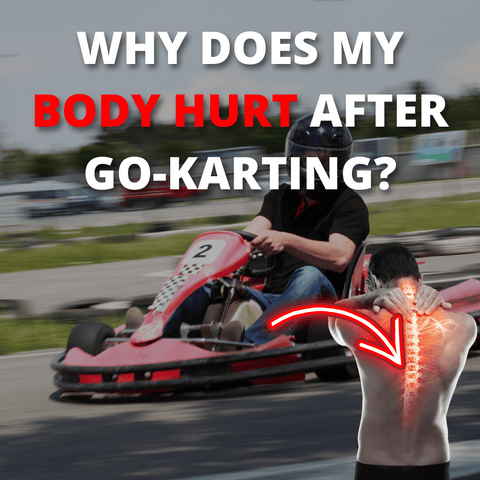
Updated: 29.4.25
Welcome to our deep dive into the world of karting—a sport that demands not just skill and nerve but also a high degree of physical conditioning.
Whether you're a young racer dreaming of the checkered flag or a parent supporting a budding karting talent, understanding the ins and outs of physical preparation is key to success on the track.
Let's gear up and explore how you can enhance performance, minimise injury risk, and increase stamina through targeted physical conditioning.
The Pillars of Physical Preparation
Cardiovascular Fitness
At the heart of any racer's physical conditioning lies cardiovascular fitness. It's what sustains you through the high-intensity demands of karting, ensuring your muscles get the oxygen they need to perform lap after lap.
Running, cycling, swimming, and engaging in interval training are fantastic ways to build your endurance.
Strength and Core Stability
Steering a kart requires control, stability, and strength. Incorporating squats, lunges, planks, and medicine ball exercises builds the muscle groups most engaged during a race.
Related: Why Does My Body Hurt After Go-Karting?

Flexibility and Mobility
Dynamic stretching, yoga, and foam rolling help maintain flexibility to navigate the demands of karting with agility and precision.
Enhancing Driving Skills Through Conditioning
Balance and Coordination
Karting demands exquisite balance and coordination. Exercises like balance board drills, agility ladders, and ball games enhance steering precision and overall handling.
Mental Conditioning
Techniques such as visualization, goal setting, and concentration exercises build mental resilience for peak performance on the track.
Supporting Performance Off the Track
Nutrition and Hydration
A balanced diet and proper hydration fuel your racing performance. Carbs, proteins, and fats combined with sufficient water intake keep your body race-ready.
Rest and Recovery
Recovery periods are crucial. Active rest, sleep, and rest days allow the body to repair, adapt, and grow stronger for future competitions.
Safety and Preparedness
While chasing speed, never compromise on safety. Using proper gear, respecting track rules, and practicing sportsmanship keep racing both fun and safe.
Does Go-Karting Build Muscle?
Absolutely! Go-karting builds muscular endurance, especially in the arms, shoulders, forearms, neck, and core. Although it won't bulk you up, it significantly improves strength, stamina, and handling capabilities over time.
Why Arm Strength Is Vital for Go-Karting
Arm strength is critical for kart control. Drivers must maintain strong grip and resist fatigue during races. Training arms and shoulders helps maintain performance, especially during intense, long sessions.
Go-Karting and Muscle Strength: What You Need to Know
Karting builds total-body strength. Core muscles stabilize through corners, shoulders control the wheel, and strong legs ensure consistent braking and acceleration. A balanced strength regimen enhances performance and prevents injuries.
Simple Karting Workout Plan
- Day 1 (Cardio + Core): 20 min interval running, planks, Russian twists
- Day 2 (Upper Body Strength): Push-ups, dumbbell rows, bicep curls
- Day 3 (Mobility & Balance): Dynamic stretching, balance board drills, yoga flow
- Day 4 (Optional Recovery): Light swimming or cycling, foam rolling
Extra Tips for Building Karting Strength
- Grip Strength: Hand grippers or tennis ball squeezes
- Neck Strength: Resistance band exercises
- Forearm Conditioning: Farmer’s carries
- Core Activation: Bird-dog exercises, side planks
Conclusion
Physical conditioning for karting is a full-circle approach, balancing cardio, strength, mobility, mental preparation, and nutrition. Proper support and training lead to a safer, more successful karting journey. Embrace the challenge and race toward victory!
FAQs
How often should my child engage in physical conditioning for karting?
Ideally 3-4 times per week with a balanced focus on cardio, strength, and mobility exercises.
Can physical conditioning improve my child's reaction time in karting?
Yes, it sharpens reflexes and decision-making by improving balance, coordination, and mental focus.
What role does nutrition play in my child's karting performance?
Proper nutrition fuels energy, supports muscle repair, and maintains peak mental function during races.
At what age can my child start physical conditioning for karting?
General fitness activities can begin around 6 years old, tailored to developmental stages and safety.
Get in Touch 🚀
Loved our article on “Turbocharge Your Karting Journey with These Physical Conditioning Tips”? Dive into more awesome info at RiiRoo.com!
Or, chat with us directly via our Live Chat for expert advice!






Share:
The Importance Of Body Position In Karting
How to Start Go Kart Racing: 10 Tips to Master Your First Race Start